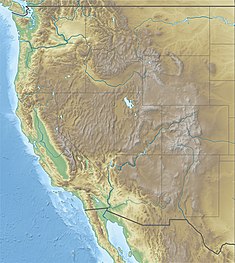Glen Canyon Dam
| Glen Canyon Dam | |
|---|---|

Glen Canyon Dam and Bridge, looking upstream
|
|
|
Location of Glen Canyon Dam in the western U.S.
|
|
| Country | United States |
| Location | Coconino County, Arizona |
| Coordinates | 36°56′15″N 111°29′04″W / 36.93750°N 111.48444°WCoordinates: 36°56′15″N 111°29′04″W / 36.93750°N 111.48444°W |
| Construction began | 1956 |
| Opening date | 1966 |
| Construction cost | $135 million ($997 million in 2017 dollars) |
| Owner(s) | U.S. Bureau of Reclamation |
| Dam and spillways | |
| Type of dam | Arch-gravity dam |
| Impounds | Colorado River |
| Height (foundation) | 710 ft (220 m) |
| Length | 1,560 ft (480 m) |
| Elevation at crest | 3,715 ft (1,132 m) |
| Spillway type | Tunnel, gated |
| Spillway capacity | 208,000 cu ft/s (5,900 m3/s) |
| Reservoir | |
| Creates | Lake Powell |
| Total capacity | 27,000,000 acre·ft (33 km3) |
| Catchment area | 108,335 sq mi (280,590 km2) |
| Surface area | 161,390 acres (65,310 ha) |
| Power station | |
| Commission date | 1964 (first 2 units) |
| Turbines | 8x 254,000 hp Francis turbines |
| Installed capacity | 1,320 MW |
| Annual generation | 4,717 GWh |
Glen Canyon Dam is a concrete arch-gravity dam on the Colorado River in northern Arizona, United States, near the town of Page. The 710-foot (220 m) high dam was built by the U.S. Bureau of Reclamation (USBR) from 1956 to 1966 and forms Lake Powell, one of the largest man-made reservoirs in the U.S. with a capacity of 27 million acre feet (33 km3). The dam is named for Glen Canyon, a series of deep sandstone gorges now flooded by the reservoir; Lake Powell is named for John Wesley Powell, who in 1869 led the first expedition to traverse the Colorado's Grand Canyon by boat.
A dam in Glen Canyon was studied as early as 1924, but these plans were initially dropped in favor of a dam in Black Canyon (the Hoover Dam, completed in 1936). By the 1950s, due to rapid population growth in the seven U.S. and two Mexican states comprising the Colorado River Basin, the Bureau of Reclamation deemed the construction of additional reservoirs necessary. However, the USBR faced opposition when it proposed the Echo Park Dam in Utah's Dinosaur National Monument, which the nascent environmental movement saw as a legal threat to the status of protected lands. After a long fight, the USBR agreed not to build the dam in Dinosaur, but only if the environmentalists did not oppose the proposed dam in Glen Canyon.
Since first filling to capacity in 1980, Lake Powell water levels have fluctuated greatly depending on water demand and annual runoff. Operation of Glen Canyon Dam helps ensure an equitable distribution of water between the states of the Upper Colorado River Basin (Colorado, Wyoming, and most of New Mexico and Utah) and the Lower Basin (California, Nevada and most of Arizona). During years of drought, Glen Canyon guarantees a water delivery to the Lower Basin states, without the need for rationing in the Upper Basin. In wet years, it captures extra runoff for future use. The dam is also a major source of hydroelectricity, averaging over 4 billion kilowatt hours per year. The long and winding Lake Powell, known for its scenic beauty and recreational opportunities including houseboating, fishing and water-skiing, attracts millions of tourists each year to the Glen Canyon National Recreation Area.
...
Wikipedia

